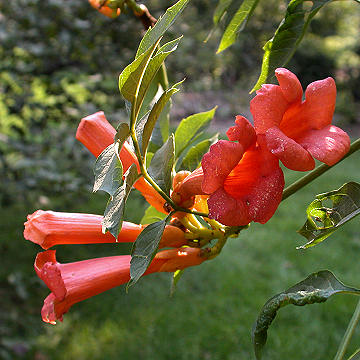

Campsis radicans - (image 1 of 4)
Taxonomy
Family: Bignoniaceae
Habitat
Low woods and thickets. Sometimes found growing on disturbed ground, road cuts, railways, floodplains.
Associates
Often weedy.
Distribution
NJ west to OH and IA, south to FL and TX. Has been introduced further west and north.
Morphology
Woody vine to 10 m or more. Leaves pinnate compound; leaflets 7-11, shiny green, sharply serrate, acuminate, rounded at the base. The red-orange, tubular flowers are borne in a crowded, terminal inflorescence and give rise to large capsules up to 15 cm long. Capsules split lengthwise and release numerous winged seeds.
Notes
Flowers mid June to late September
Wetland indicator: Facultative
Popular as an ornamental. Flowers attract hummingbirds. A robust vine that has been introduced outside of its natural range to become somewhat of a weed. Scarlet honeysuckle (Lonicera sempervirens) is a good substitute where this species may be problematic.
References
Gleason, Henry A. and A. Cronquist. 1991. Manual of Vascular Plants of Northeastern United States and Adjacent Canada. Second Ed.
The New York Botanical Garden. Bronx, NY
Swink, F. and G. Wilhelm. 1994. Plants of the Chicago Region.
Indiana Academy of Science. The Morton Arboretum. Lisle, Illinois.
Niering, W. A. 1979. The Audubon society field guide to North American
wildflowers: Eastern region.
Knopf/Random House, New York.
|
© Michael Hough 2004 |